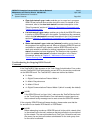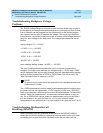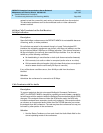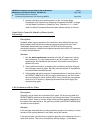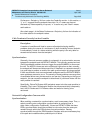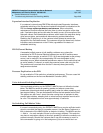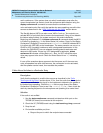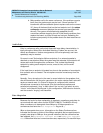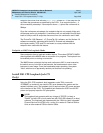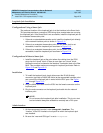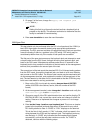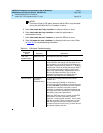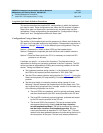
DEFINITY Enterprise Communications Server Release 5
Maintenance and Test for R5vs/si
555-230-123
Issue 1
April 1997
Routine Maintenance Procedures
Page 5-68Troubleshooting Multimedia Call Handling (MMCH)
5
b. Make another call to the same conference. If the problem corrects
itself, then the previous port may be bad. If there are other VC
boards with sufficient available ports to replace calls on the current
VC, then pull the board that has the bad endpoint on it (the status
conference command displays the encoder port associated with
the call). The system will automatically reestablish the VC
connections without dropping the call. If this fixes the problem, then
replace the board, as it has at least one bad port. Reseating the
board may temporarily fix the problem due to the hard reset done to
the board.
Audio Echo
Echo in conference calls, particularly those with large delay characteristics, is
totally disruptive. When Voice Activated Switching is taken into account, the
effects are disastrous. Various arrangements of the microphone(s) and room
speaker(s) may be needed.
For some Lucent Technologies Vistium endpoints, if an external speaker is
attached or was attached when the system was last rebooted, this endpoint will
cause audio echo throughout the conference. First, isolate the offending
endpoint by asking each endpoint to mute, one at a time, until the echo
disappears.
If the input from an endpoint is located too close to the speakers of an endpoint,
then acoustic echo is created. The microphone must be moved away from the
speakers.
Normally, if any microphone in the room is moved relative to the speakers, that
site will cause echo until the echo canceller in the codec retrains itself, some will
require a manual reset. If a PictureTel keypad is configured with external
microphones connected to the keypad, then the internal microphone and
external microphone(s) “sing” to each other if the “ext mic” bat switch is set to
“int mic” on the back of the keypad. In this configuration, VAS locked on that site,
and the acoustic “singing” was inaudible.
Rate Adaptation
Because of a lack of a clear explanation in standards, sometimes endpoints do
not work well with each other and the DEFINITY MMCH. The MMCH will only
allow a conference to downgrade from 64kbps to 56 kbps operation on
conferences that have the Rate Adaptation flag set to y.
When a downgrade does occur, information on the Status Conference form
indicates the success or failure of the 64kbps-endpoints that are participants to
properly rate adapt to 56kbps. As a general indication that the conference has
rate adapted, the Conference Transfer Rate and Effective Transfer
Rate fields show initial and current transfer rates, respectively. For each 64-kbps




